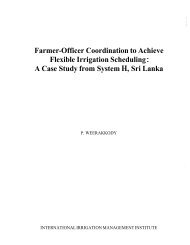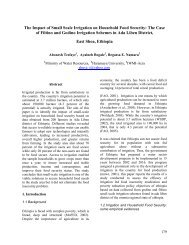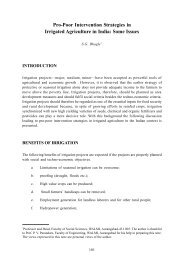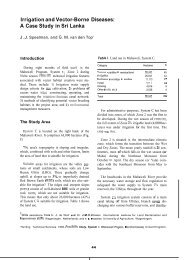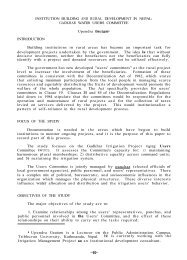WATER POVERTY IN THE NORTHEASTERN HILL REGION (INDIA)
WATER POVERTY IN THE NORTHEASTERN HILL REGION (INDIA)
WATER POVERTY IN THE NORTHEASTERN HILL REGION (INDIA)
Create successful ePaper yourself
Turn your PDF publications into a flip-book with our unique Google optimized e-Paper software.
<strong>WATER</strong> <strong>POVERTY</strong> <strong>IN</strong> <strong>THE</strong> NOR<strong>THE</strong>ASTERN <strong>HILL</strong> <strong>REGION</strong> (<strong>IN</strong>DIA): POTENTIAL ALLEVIATION THROUGH MULTIPLE-USE <strong>WATER</strong> SYSTEMSWater resources availability: Too-much - too-little syndrome in the Himalayan hilly regions(Photo credit: Deepak Adhikary, IDE)agriculture is generally above 20%. Services provided by the government form a substantial driver ofconsumer demand in smaller states. Agriculture in the region is subsistence oriented as indicated bylow consumption of fertilisers, low coverage under irrigation and low yields compared to the nationalaverage. Paddy is the main crop of the region. Much agriculture is practised in single season. Whereflooding does not damage crops, the cropping is done in Sali (kharif, rainy) season and in regionsaffected by floods, crops are taken after the floods recede. Other crops taken in the region includemustard, potato, maize and a wide variety of vegetables but all with very low yields. Hilly states showwide prevalence of horticultural crops such as arecanut, citrus, pineapple, banana and ginger. Theregion is bulk producer of tea under commercially run tea estates.In most hilly states, people tend to have backyards or ‘homesteads’ (termed bari in local language) whichgrow a number of crops produced mostly for home consumption. These include bamboo, coconut,arecanut, yams, banana and a range of vegetables. Homesteads also support small scale livestock suchas pigs, goat and poultry including ducks. Presently, production from these homesteads is highlyinadequate to meet the family needs. These homesteads have the potential to provide main nutrition andlivelihoods to the families, especially women if these are provided with small but assured sources of water andrelated inputs and some markets and thus act as instruments for alleviating poverty.To arrive at suitable interventions for improving the access to water resources and alleviate waterpoverty of the population of the northeast region, it is essential that first we map the water povertyof a representative inhabitation and identify the contributing factors. The next section deals with themethodology and outcome of a village level study on water poverty mapping for a village in Mon districtof Nagaland state.3. Mapping Water Poverty in the Northeast RegionWater poverty mapping (WPM) can be defined as the mapping of water poverty indicators, aggregatedto a suitable spatial scale for the purpose of identifying areas of high levels of water poverty, so as toassist in targeting of water related policies and infrastructure to ensure the most effective use of scarceresources (natural, financial, and institutional) to meet the development objectives of the region. Water7



